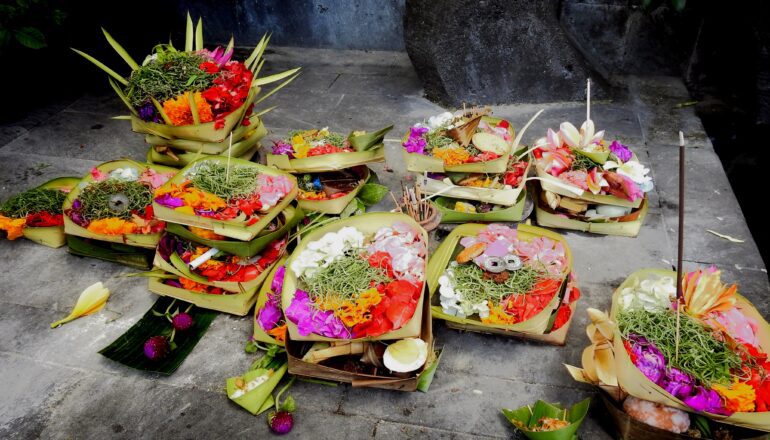Bali, famously known as the “Island of the Gods,” possesses a deeply spiritual culture. Religion and rituals infuse every aspect of daily life. Among these practices, one element stands out as a symbol of devotion and gratitude—Canang Sari. If you have ever wandered the streets of Bali, you have surely noticed small, colorful offerings placed on sidewalks, in temples, on shrines, or even on vehicles. These are Canang Sari, a vital part of the daily spiritual life of the Balinese people.
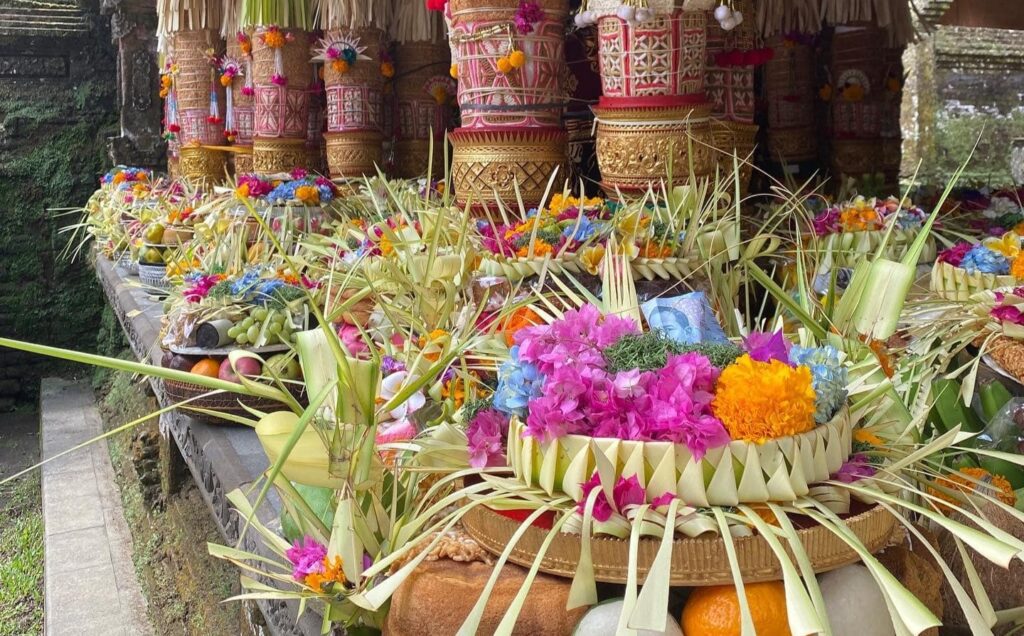
This article explores everything about Canang Sari. You will learn its history, philosophy, ingredients, preparation process, symbolism, spiritual significance, and role in contemporary Balinese life. By the end, you will understand why Canang Sari is not merely an offering but a profound expression of devotion and harmony.
Click Here: Tamblingan and Buyan Lakes: A Guide to Bali’s Twin Lakes
The Origins and History of Canang Sari
Ancient Roots in Hinduism
The tradition of Canang Sari stems from Balinese Hinduism, an ancient faith derived from Hindu beliefs brought by Indian traders and Brahmins centuries ago. Over time, these beliefs merged with local animism and ancestral worship to form the distinct Balinese Hinduism practiced today.
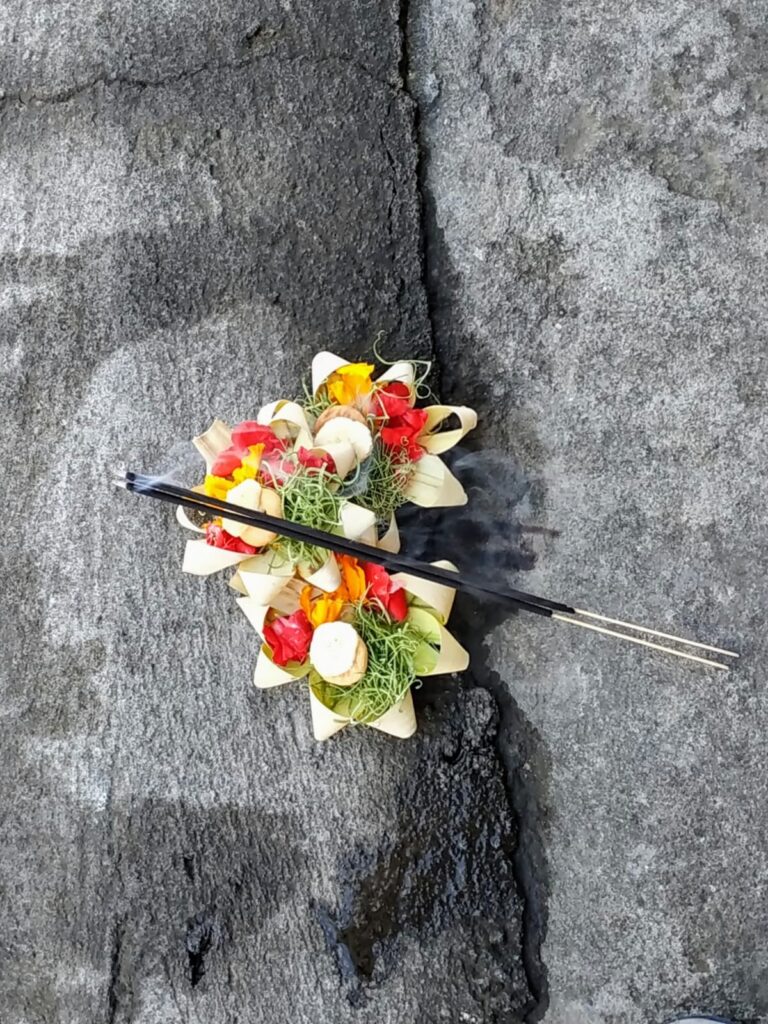
The word Canang Sari has Sanskrit origins:
- Ca means “beautiful.”
- Nang or Nanga means “purpose” or “aim.”
- Sari refers to “essence” or “core.”
Thus, Canang Sari translates to “the beautiful purpose’s essence”—a gift of beauty offered with sincere intention.
The Evolution of Offerings in Bali
Offerings have always been a core part of Balinese spiritual life. In ancient times, offerings consisted of simple items like leaves, fruits, or rice. As society advanced, offerings became more elaborate. Canang Sari emerged as the most fundamental and frequent offering.
Initially used only in temples, This offerings gradually became a daily ritual practiced by households, businesses, and even tourists embracing Balinese spirituality.
The Meaning and Philosophy Behind Canang Sari
Symbol of Gratitude and Balance
The essence of Canang Sari lies in gratitude. Balinese Hindus offer Canang Sari as thanks to Sang Hyang Widhi Wasa, the supreme deity, for peace and blessings in life. It reflects their desire to maintain balance between the Sekala (physical world) and the Niskala (spiritual world).
The Concept of Tri Hita Karana
Canang Sari embodies the Tri Hita Karana philosophy, which encourages:
- Harmony with God (Parahyangan)
- Harmony with humans (Pawongan)
- Harmony with nature (Palemahan)
Balinese people believe that by offering Canang Sari, they nurture these three relationships and maintain universal harmony.
The Components of Canang Sari
Every component of this offerings holds symbolic significance, carefully selected and arranged to convey specific meanings.
1. The Base (Ceper)
- Made of woven palm leaves, often square or round in shape.
- Symbolizes the world and serves as a foundation for life.
2. Porosan
- A small packet containing betel leaf, areca nut, and lime.
- Represents the essence of life: Tri Murti deities (Brahma, Vishnu, Shiva).
- Signifies the three main powers of creation, preservation, and destruction.
3. Sampian Urasari
- A decorative piece made of young coconut leaves (janur).
- Placed atop the offering to add artistic beauty and balance.
4. Flowers (Bunga)
- Different colored flowers represent the four cardinal directions and specific gods:
- White flowers (East): Represent Iswara, the god of purity.
- Red flowers (South): Represent Brahma, the god of creation.
- Yellow flowers (West): Represent Mahadeva, the god of prosperity.
- Blue or green flowers (North): Represent Vishnu, the god of protection.
5. Sari (Essence)
- A drop of holy water or sometimes money or food (coins, candy, rice).
- Signifies the essence of the offering—the pure intention of the giver.
6. Incense (Dupa)
- Burned during the offering ritual.
- Its smoke carries the prayer upward to the heavens.
How to Make Balinese Offerings
Creating this offerings is a sacred task, often passed from mother to daughter. The process requires skill, patience, and devotion.
Materials Needed
- Palm leaves (janur)
- Betel leaf, areca nut, lime (Porosan)
- Fresh flowers (white, red, yellow, blue/green)
- Small coins or food as Sari
- Incense sticks (dupa)
Step-by-Step Guide
1: Weaving the Ceper Base
- Cut palm leaves into thin strips.
- Weave them into a square or round tray.
- Secure the edges using small bamboo sticks or coconut pins.
2: Preparing Porosan
- Fold a betel leaf to create a small packet.
- Insert areca nut and lime paste.
- This bundle sits in the center of the base.
3: Arranging Sampian Urasari
- Create decorative designs using young coconut leaves.
- These are placed on top of the Porosan, forming a tiered structure.
4: Placing the Flowers
- Arrange flowers by color and direction:
- White in the East
- Red in the South
- Yellow in the West
- Blue or green in the North
- Some add an extra flower in the center, representing balance and unity.
Step 5: Adding Sari and Incense
- Place a small coin, rice grain, or sweet treat as the Sari.
- Insert an incense stick before the offering is placed.
The Ritual of Offering Canang Sari
Best Time to Offer
- Morning: Most offerings are placed before 9 AM.
- Some are offered in the afternoon or evening, depending on the ritual.
How to Present This Offerings
- Light the incense stick.
- Hold the offering with both hands while praying silently.
- Sprinkle holy water on the offering.
- Place it on shrines, entrances, or ground level (for spirits of lower realms).
The Spiritual Significance of Canang Sari
Maintaining Cosmic Balance
Balinese believe that spirits inhabit the world, both benevolent and malevolent. This offerings honors the good spirits and appeases mischievous ones, ensuring spiritual balance.
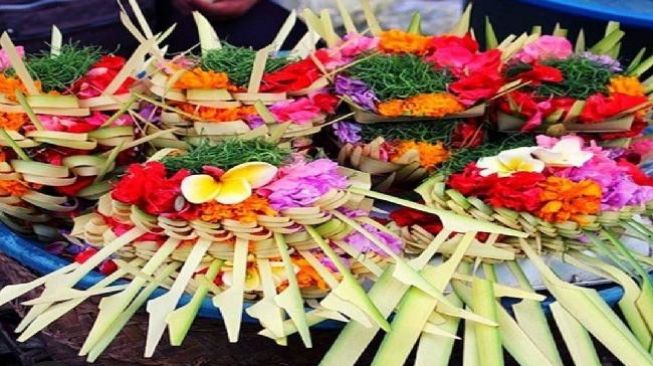
A Daily Act of Gratitude
The offering serves as a daily reminder to be thankful for life’s blessings, whether health, family, or prosperity.
Self-Purification and Karma
Through making and offering, Balinese people cleanse their souls, reduce karma, and maintain spiritual discipline.
Variations of Canang Sari in Different Contexts
For Homes and Temples
- Placed at family shrines and temple altars.
- Usually more elaborate and colorful.
For Vehicles and Shops
- Smaller versions are offered on cars, motorcycles, and storefronts.
- To seek protection and good fortune in daily activities.
During Ceremonies
- Canang Sari is included in larger ceremonies like Galungan, Kuningan, and Odalan.
- The design may be grander, with additional fruits and cakes.
The Role of Women in Offerings Preparation
A Sacred Duty
Balinese women dedicate significant time to preparing Canang Sari. They wake early to gather materials and weave baskets with love and mindfulness.
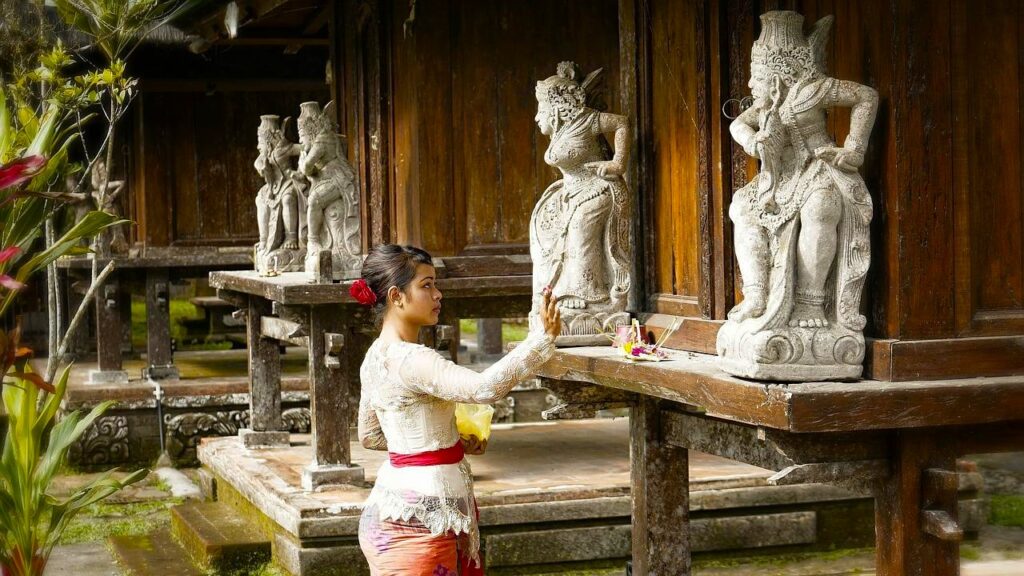
Passing Down Traditions
Mothers teach their daughters intricate weaving techniques and the spiritual meaning behind each element. This tradition preserves cultural heritage across generations.
Canang Sari in Modern Balinese Society
Tourism and Cultural Exchange
Many tourists are fascinated by Canang Sari and often participate in workshops to learn how to make them. Hotels and resorts frequently incorporate Canang Sari into their guest experiences.
Balancing Modern Life and Tradition
Even in the face of modernization, Balinese people maintain their commitment to Canang Sari. Office workers, shopkeepers, and taxi drivers take time to make offerings each day.
Environmental Concerns and Sustainable Practices
The Challenge of Waste
The widespread use of plastic decorations and non-biodegradable materials in this offerings has caused environmental issues.
Promoting Eco-Friendly Offerings
Some communities are returning to traditional methods, using only natural materials like palm leaves, bamboo, and organic flowers. Educational campaigns encourage sustainability to protect Bali’s environment.
How Tourists Can Respect
Cultural Sensitivity Tips
- Do not step on Canang Sari found on sidewalks.
- Observe quietly when people are praying.
- Ask permission before photographing offerings.
Participating Respectfully
Many Balinese are happy to teach tourists about their traditions. Participating in offering-making classes deepens your understanding of Balinese culture.
Conclusion
Canang Sari represents the essence of Balinese life, blending spirituality, tradition, and art. It is much more than an offering—it is a daily expression of gratitude, an act of maintaining cosmic balance, and a symbol of harmony between the human and divine.
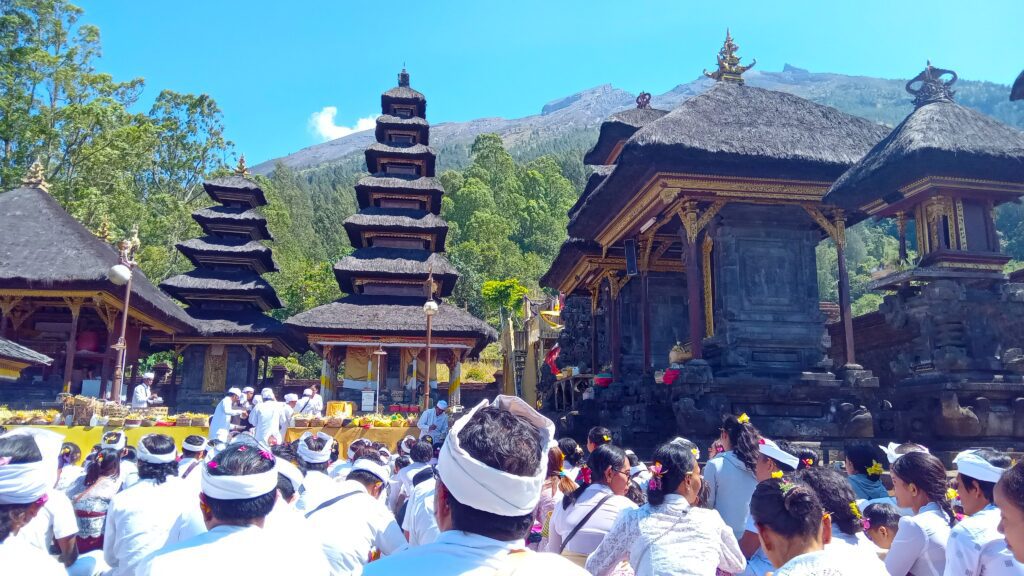
By learning about Canang Sari, you gain insight into Balinese Hindu philosophy, appreciate their devotion to community and nature, and understand why Bali remains such a spiritually rich and peaceful island.
FAQs About Canang Sari
1. Why do Balinese people offer Canang Sari daily?
They offer it as an expression of gratitude to God and to maintain harmony in life.
2. What does the incense in Balinese Offerings symbolize?
Incense smoke carries prayers and offerings to the spiritual realm.
3. Can tourists make Balinese Offerings?
Yes! Many workshops in Bali offer hands-on classes that welcome tourists.
4. Is there a best time to offer Canang Sari?
Most offerings happen in the morning, but they can be made throughout the day.
5. Why are there Canang Sari on sidewalks?
These offerings are intended for lower spirits to maintain balance between positive and negative energies.
Read Here: Nyepi Day in Bali: A Complete Guide to the Balinese Day of Silence
The Best Trip Destination
Bali, Indonesia, beckons with its diverse allure. Explore Ubud’s cultural treasures, witness the iconic Tanah Lot Temple at sunset, and surf the waves of Kuta Beach. Discover the scenic beauty of Tegallalang Rice Terraces and embrace the lively atmosphere of Seminyak. Dive into the underwater wonders of Amed, relax on the pristine shores of Nusa Dua, and wander through ancient temples in the heart of Bali. Whether seeking vibrant nightlife, serene landscapes, or cultural richness, Bali’s enchanting destinations cater to every traveler’s desire.
Ubud (14 Trips)
Eastern Bali (7 Trips)
Southern Bali (5 Trips)
Northern Bali (5 Trips)
Nusa Penida Island (4 Trips)
Western Bali (4 Trips)
The Best Activities In Bali
Indulge in Bali’s diverse activities, from surfing the waves in Kuta to exploring cultural treasures in Ubud. Snorkel vibrant coral reefs in Amed, trek lush rice terraces, and rejuvenate in serene spa retreats. Dive into the lively nightlife of Seminyak, witness traditional dance performances, and sample local delicacies in bustling markets. Whether it’s hiking Mount Batur for a sunrise vista or embracing the spiritual ambiance of ancient temples, Bali offers a kaleidoscope of experiences for every traveler’s passion.

